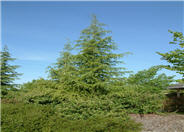
Common name:Deodar Cedar
Botanical name:Cedrus deodara
This fast-growing, coniferous evergreen is capable of reaching a size of 80' high by 40' wide. Its needles are a light, silvery green color, 2" long. Flowers are inconspicuous. Barrel shaped cones appear in fall and winter. Branches are pendulous and spreadings. Plant in area that has ample room for growth.
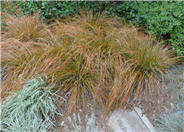
Common name:Orange or Brown Sedge
Botanical name:Carex testacea
The testacea variety is an evergreen perennial that reaches 2' tall bearing very narrow, coppery brown leaves splitting to hair-like threads at their tips, and continuing to grow to 4-8' in length. This plant should be grown in sun with little or no summer watering. During winter, foliage turns orange. If this grass is planted in shade, foliage stays green. Flowers are insignificant. Orange Sedge looks great in containers or spilling over near walkways or into water features.
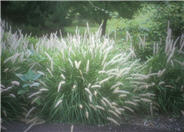
Common name:Oriental Fountain Grass
Botanical name:Pennisetum orientale
Oriental Fountain Grass is a clumping, warm-season grass with spectacular pinkish white flowers in summer and sometimes fall. Flower plumes change to light brown. Foliage is a bright green that changes to straw color as winter approaches. This grass is 1'-2.5' tall and wide. It usually does not reseed. This grass is striking if backlit to show off flower plumes.
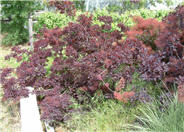
Common name:Royal Purple Smoke Tree
Botanical name:Cotinus coggygria 'Royal Purple'
Royal Purple Smokebrush is a large shrub or small tree with handsome, oval purple leaves all summer which turn scarlet color in the fall. Silvery-purple clouds of seed heads appear in fall. This striking shrub prefers full sun and low amount of watering once it's established. Prune in winter to shape. This shrub reaches 15' tall and 10' wide.
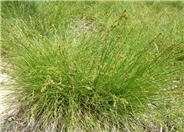
Common name:Common Field or Slender Sedge
Botanical name:Carex praegracilis
This California native grass can tolerate occasional flooding or standing water as it is found in marshes and wetlands. It does make a great lawn substitute as it can be mowed, will take sun and part sun and need watering once a week in hot summer months. This sedge uses much less water than sod. It can be used for erosion control also.
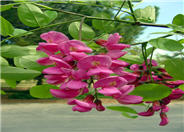
Common name:Idaho Locust
Botanical name:Robinia X ambigua 'Idahoensis'
This tree will grow 40' tall by 30' wide and has small, light green leaves with clusters of bright magenta fragrant flowers that bloom in spring. Leaves turn yellow in fall and then drop. This upward arching tree tolerates heat as well as cold. Idaho Locust prefers full to part sun and well draining soil. This variety has no seed pods.
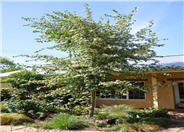
Common name:Washington Thorn
Botanical name:Crataegus phaenopyrum
This deciduous tree grows to a height of 20' tall and wide, with glossy green leaves 2"-3" long and 3-5 pointed lobes. In the spring, small white clusters of flowers appear. Some folks say the flowers are malodorous. Thorns appear on the twigs during the growing season. Shiny green fruit turns orange when ripe in the fall. Fruit can be made into jellies. Birds love them too.

Common name:Shrub Rose
Botanical name:Rosa Shrub varieties
The dark green, heavily veined leaves of this bushy shrub are strong support for the pure white or pink, nearly double flowers it produces. This is a very tolerant, heavily scented plant with an impressive fall color. Also, large hips appear intermittently with this plant.
| Designer: Jody Palmer | High and Low |
Photographer: GardenSoft |
Soils and Compost:
Incorporate compost 6" into your soil to retain water, reduce compaction, feed earthworms, and provide valuable nutrients to your plants.
Water Saving Tip:
Fix leaking sprinklers, valves, and pipes.
One broken spray sprinkler can waste 10 gallons per minute - or 100 gallons in a typical 10 minute watering cycle.
Integrated Pest Management:
Attract, or buy beneficial insects such as ladybugs and lacewings to control pest outbreaks in your garden.

